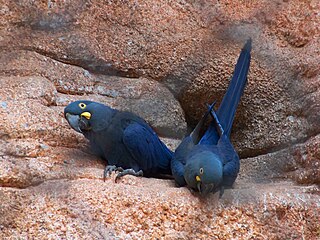
Lear's macaw, also known as the indigo macaw, is a large all-blue Brazilian parrot, a member of a large group of neotropical parrots known as macaws. It was first described by Charles Lucien Bonaparte in 1856. Lear's macaw is 70–75 cm long and weighs around 950 g. It is coloured almost completely blue, with a yellow patch of skin at the base of the heavy, black bill.

The eclectus parrot is a parrot native to the Solomon Islands, Sumba, New Guinea and nearby islands, northeastern Australia, and the Maluku Islands (Moluccas). It is unusual in the parrot family for its extreme sexual dimorphism of the colours of the plumage; the male having a mostly bright emerald green plumage and the female a mostly bright red and purple/blue plumage. Joseph Forshaw, in his book Parrots of the World, noted that the first European ornithologists to see eclectus parrots thought they were of two distinct species. Large populations of this parrot remain, and they are sometimes considered pests for eating fruit off trees. Some populations restricted to relatively small islands are comparably rare. Their bright feathers are also used by native tribespeople in New Guinea as decorations.
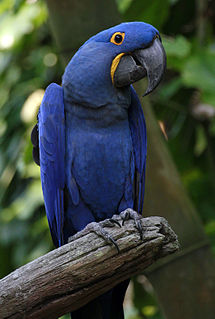
The hyacinth macaw, or hyacinthine macaw, is a parrot native to central and eastern South America. With a length of about one meter it is longer than any other species of parrot. It is the largest macaw and the largest flying parrot species; the flightless kākāpō of New Zealand outweighs it at up to 3.5 kg. While generally easily recognized, it could be confused with the smaller Lear's macaw. Habitat loss and the trapping of wild birds for the pet trade have taken a heavy toll on their population in the wild, so the species is classified as Vulnerable on the International Union for Conservation of Nature's Red List, and it is protected by its listing on Appendix I of the Convention on International Trade in Endangered Species of Wild Fauna and Flora (CITES).

East Rennell is the southern portion of Rennell Island in the Solomon Islands which is designated a UNESCO World Heritage Site. Rennell is the largest raised coral atoll in the world and the area in East Rennell surrounding Lake Tegano contains many endemic species.
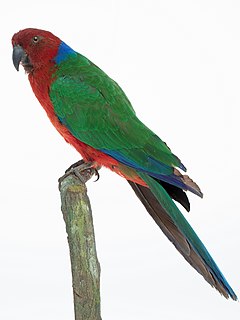
The crimson shining parrot is a parrot from Fiji. The species is endemic to the islands of Kadavu and Ono in the Kadavu Group. The species was once considered conspecific with the red shining parrot of Vanua Levu and Taveuni, but is now considered its own species. The species is sometimes known as the Kadavu musk parrot.
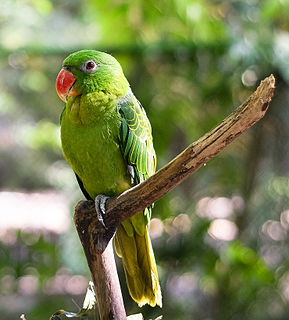
The blue-backed parrot, also known as Müller's parrot is a large, endangered species of parrot endemic to the Philippines. It is found in tropical moist lowland forests. Flocks are small and often active at night. Its main threats are habitat loss and trapping for the pet trade.

The blue-collared parrot also known as simple parrot, lilac-collared song parrot, or lilac-collared Geoffroy's parrot, is a parrot found in the higher elevations of New Guinea. It is found from 500 to 2300 m, mainly between 800 and 1900 m. It is 23–25 cm, mainly green with a black beak, yellow wing bend, blue underwing coverts, and a pale yellow iris. Adult males have a blue collar across upper breast to lower neck above the mantle, adult females have some blue on the rear crown. Juveniles have no blue and a paler bill. There are two subspecies:
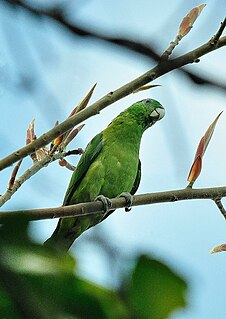
The blue-headed racket-tail, also known as the Palawan racket-tail and locally as kinawihan, is a parrot found in the western Philippines around Palawan. The species was formerly considered conspecific with the blue-crowned racket-tail. It is locally known as 'kilit'. It inhabits humid lowland forest in small flocks. It is threatened by habitat destruction and limited trapping for the cage-bird trade.

The blue-streaked lory is also known as the blue-necked lory. It is a medium-sized parrot (31 cm), which is found on the Tanimbar Islands and Babar in the southern Moluccas.

The red-and-blue lory is a small, strikingly-colored parrot endemic to Indonesia. The species inhabits a single island, Karakelong, in the Indonesian archipelago, although it was formerly found on the Sangihe Islands and other parts of the Talaud Islands.

The red-cheeked parrot is a species of parrot in the family Psittaculidae found in Indonesia, Papua New Guinea and the tip of northern Australia. There are 17 subspecies currently recognized. It is a stocky short-tailed parrot with predominantly green plumage. It exhibits sexual dimorphism; the adult male has red cheeks and a mauve nape and top of head, while the female is duller with a brown head.

Geoffroyus is a genus of parrot in the family Psittaculidae. The three species are found in and around New Guinea, the Solomon Islands, northern Australia and the islands of Indonesia. It contains the following species:
The song parrot or singing parrot is a species of parrot in the family Psittaculidae. It is found in the Bismarck Archipelago and on Bougainville Island in Papua New Guinea, and in the Solomon Islands except Rennel. Its natural habitat is subtropical or tropical moist lowland forests. This species demonstrates a large to small landmass inter-island colonization pattern based off its presence in Molehanua village, Ugi Island.

The Bismarck hanging parrot or green-fronted hanging parrot is a small species of parrot in the family Psittaculidae. It is endemic to forest in the Bismarck Archipelago in Papua New Guinea. It is threatened by habitat loss. It is sometimes considered a subspecies of the orange-fronted hanging parrot.
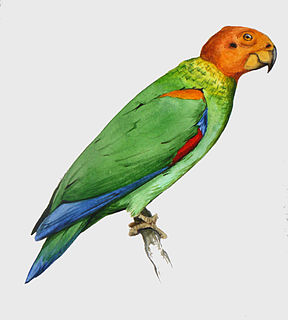
The bald parrot or orange-headed parrot is a species of parrot in the family Psittacidae. It is endemic to the east-central Amazon of Brazil. Its natural habitat is tropical moist lowland forests. It is considered near threatened by BirdLife International due to the widespread deforestation of the Amazon.

The montane racket-tail or the Luzon racket-tail, is a species of parrot in the family Psittaculidae. It was previously conspecific with the Mindanao racket-tail. It is endemic to the mountains of northern Luzon in the Philippines. It is threatened by habitat loss and the cage bird trade.
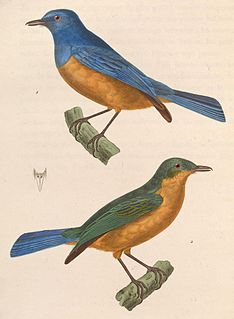
The Timor blue flycatcher is a species of bird in the family Muscicapidae. It is found on Timor island. Its natural habitats are subtropical or tropical moist lowland forests and subtropical or tropical moist montane forests.

The parrot subfamily Psittaculinae consists of three tribes: the Polytelini with three genera, the Psittaculini or Asian psittacines, and the pygmy parrots of the Micropsittini tribe.
The Mindoro racket-tail is a species of parrot in the Psittaculinae family. It was formerly considered conspecific with the blue-crowned racket-tail. It is endemic to the island of Mindoro in the Philippines and it occurs in tropical moist lowland forest. It is threatened by habitat loss and trapping for the cage-bird trade.
The Simeulue parrot is a parrot endemic to two small islands off Sumatra. It was formerly considered a subspecies of the blue-rumped parrot, but is split by the HBW/BirdLife checklist, with the IOC later following suit, supporting its status as a distinct species.
















